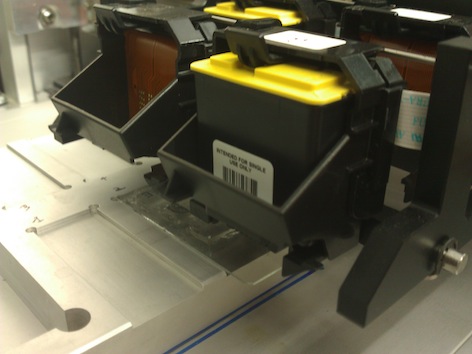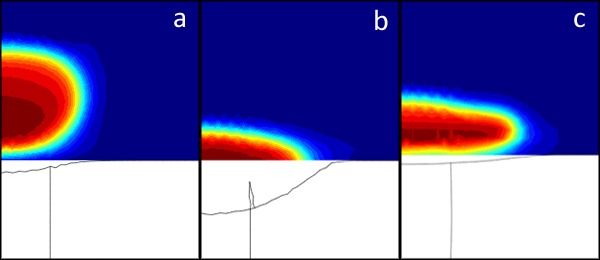High quality and precise patterns can be printed using a patented thermal ink-jet technology (NanoBioJet, R&D Olivetti I-Jet, Italy). This non-contact nano-dispensing CAD/CAM system enables picoliter to nanoliter volumes of liquid to be dispensed in precise locations.
Depending upon the chosen printhead and biological fluid, optimal printing parameters can be set: driving energy, printing frequency, pulse length. Different bio-molecules have been printed with this system (i.e. genipin, albumin-FITC), as well as nano-particles (NP) and cells (i.e. fibroblast, hepatocyte, endothelial).

Figure: Printing phase of the NanoBioJet system and example of printed pattern (i.e. University of Pisa logo)-
Recently we investigated the influence of the deposition surface mechanical properties on viability of printed cells. A Finite-Element Model (FEM) was realised to evaluate the impact force of a droplet ejected with NanoBioJet system varying the substrate properties.
Different substrates were investigated with the FEM model: from a rigid (polystyrene) to a liquid deposition substrate (cell culture medium). As shown in figure the impact force decreases with the stiffness of the deposition surface.

Figure: Droplet shape before the impact (a). Droplet shape and substrate deformation after the impact with different surfaces: a) collagen, b) polystyrene -
Fibroblasts were printed with the NanoBioJet system onto different substrates to confirm the FEM results. Cell viability was evaluated 4, 24, 48 hours after the printing. We showed that a rigid surface causes temporary damage which can be partially recovered only after 48 hours. Visco-elastic or viscous solutions influence cell viability only during the first 4 hours after the printing process and then the proliferation rate is similar to that of controls.
Contact info:
Related publications:

